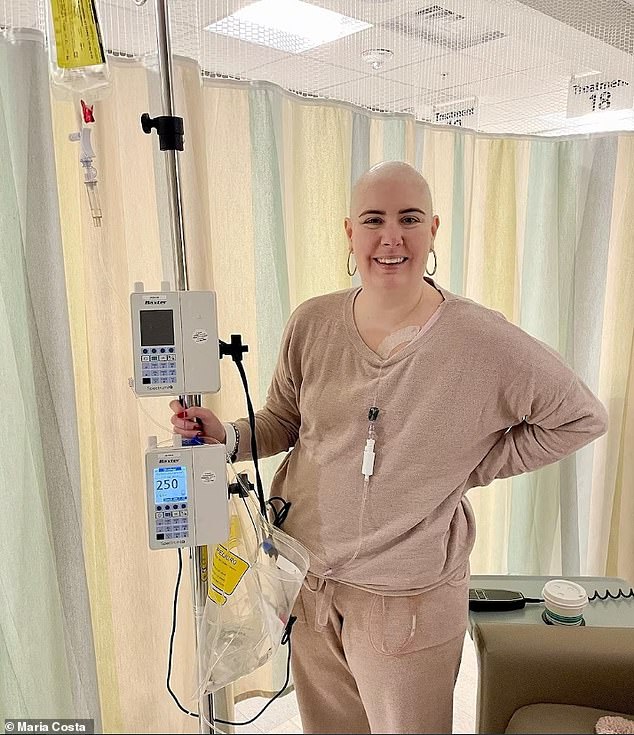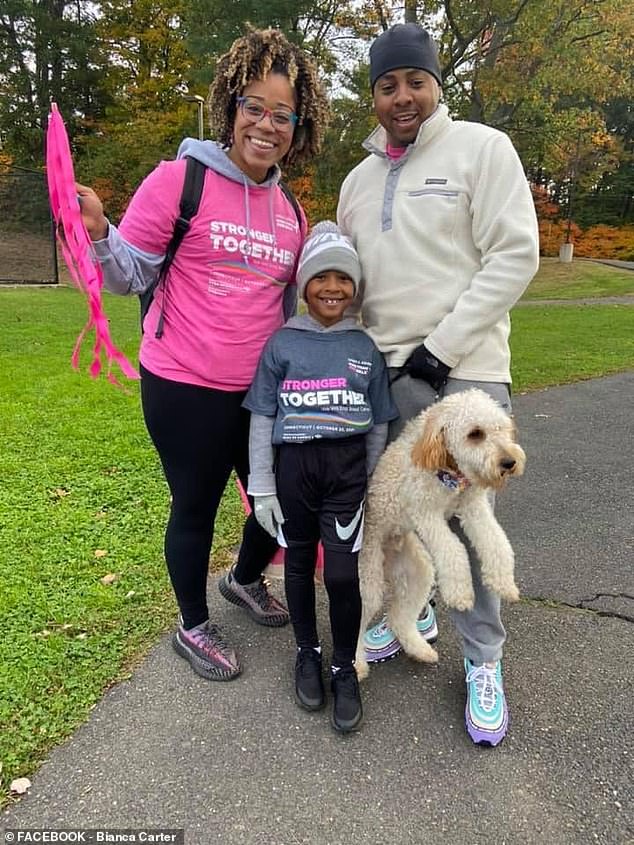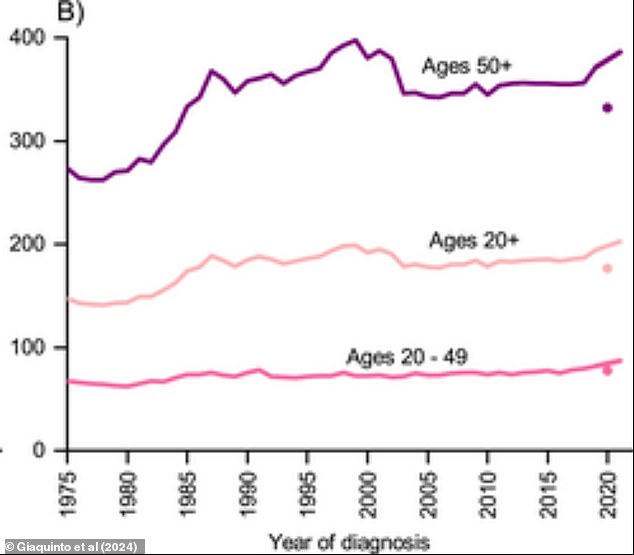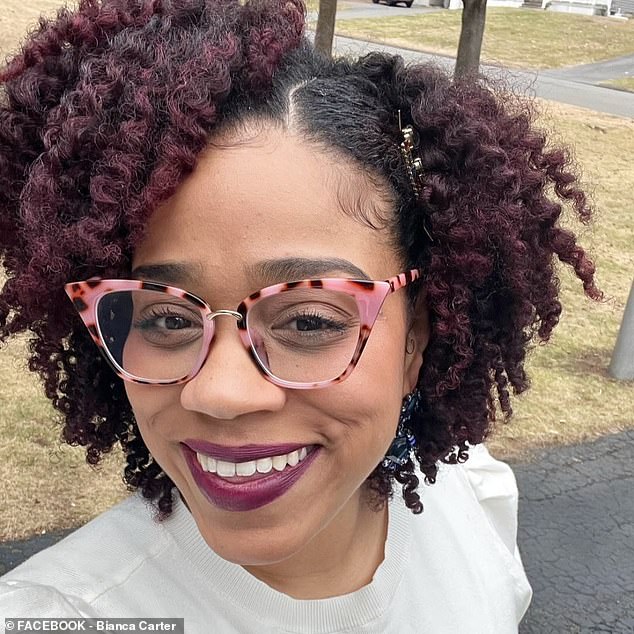Women in the prime of their lives have revealed their shock at being diagnosed with a cancer that is increasing rapidly among young women.
Breast cancer incidence is increasing at twice the rate among people under 50 than among people over 50, a trend thought to be linked to an overall increase in early-onset cancers.
Bianca Carter, from Connecticut, was 29 years old when she was diagnosed with stage three breast cancer in 2017, triggering a series of brutal surgeries that robbed her of the chance to have a big family.
Meanwhile, Maria Costa was just 33 years old when she was diagnosed with stage three invasive breast cancer in 2022, after a year of requesting a mammogram.
She is now worried that she will not be able to remarry and start a family after undergoing medically induced menopause.
Bianca Carter (pictured) was just 29 years old when she was diagnosed with stage three breast cancer. Since then, the mother of one has undergone eight surgeries, 40 rounds of radiation and 10 rounds of chemotherapy.

Maria Costa (pictured during treatment), 35, was diagnosed with stage three breast cancer after a year of requesting a mammogram. Now she fears she won’t be able to date or have children.
And Mariana Robbins of South Carolina discovered she had breast cancer after her first mammogram last year, at age 40.
Although her cancer was diagnosed at stage one, she lives in constant fear that it will return and leave her unable to watch her four-year-old son grow up.
Although the cause is unclear, experts have suggested that the increase in breast cancers among young people may be due in part to changes in reproductive habits, such as having children later and starting menstruation earlier.
In response to rising breast cancer rates, the U.S. Preventive Services Task Force in April lowered the recommended age for screening from 50 to 40.
The agency predicted that this measure could prevent 1.3 cases of breast cancer death per 1,000 women over a lifetime of screening.
However, this still excludes women in their 20s and 30s.
And because women in these age groups historically have such a low risk of contracting the disease, many women say their early symptoms are ignored.
When Mrs. Carter sought medical help after detecting a lump in her breast, doctors initially refused to perform tests and insisted the lump was not there.
She told Good Morning America that she had to be “really persistent” before the team finally relented and gave her an ultrasound and a mammogram.
Despite having no family history, Ms. Carter was diagnosed with stage three invasive ductal carcinoma, which accounts for approximately eight in 10 breast cancers.
While the survival rate for this form of cancer is almost 100 percent in the early stages, it drops to 31 percent when it spreads to lymph nodes and surrounding organs.
Just nine months after her diagnosis, Mrs. Carter underwent eight surgeries, including a double mastectomy and a full hysterectomy, in addition to 40 rounds of radiation and 10 rounds of chemotherapy.
Now, she and her husband can no longer have the big family they dreamed of due to the hysterectomy and hormonal treatments, in which she will remain for at least five more years.
Mrs Carter said: ‘Just like a woman, you’re almost stripped of that femininity. They strip you of your breasts and your female reproductive system… It’s not what it used to be.’

Mrs Carter, pictured with her husband, son and dog, said her cancer required her to undergo a hysterectomy, depriving her of the opportunity to have a big family.
Ms. Costa asked her gynecologist for a mammogram in 2021 because both her mother and aunt were diagnosed with breast cancer. A year later, even when her doctor felt a lump in her breast, she was told she was still too young.
But shortly after she finally had a mammogram, Ms. Costa was diagnosed with stage three invasive lobular carcinoma, a rare, slow-growing breast cancer that begins in the milk-producing glands of the breast.
This form accounts for about one in 10 breast cancers, according to the nonprofit organization Breastcancer.org. As with invasive ductal carcinoma, the survival rate is almost 100 percent in the early stages, although it can drop to 22 percent after it spreads.
Costa, now 35, told Good Morning America: “I had to fight for doctors to listen to me, and if I was diagnosed in 2021, my journey might have been different.” “I’ve had an extremely difficult journey since I was diagnosed.”
She was put through medically induced menopause, which helps reduce levels of hormones like estrogen that can increase the risk of the cancer spreading or coming back.
Additionally, he said multiple surgeries have left his chest looking deformed and that reconstructive surgery is on hold.
Ms Costa said: “On bad days, I say, ‘I’m bald and I have no chest.’ How do I explain that? If I want to go on a date, how do I have this conversation?”
Ms Robbins, now 41, was diagnosed with stage one invasive breast cancer last year. It is not clear what specific form it takes, but invasive breast cancer includes invasive ductal carcinoma, invasive lobular carcinoma, inflammatory breast cancer, and triple-negative breast cancer.
She had just had her first mammogram.
Although diagnosed at an early stage, the treatment still left Ms Robbins with serious side effects, including nerve pain.
She said: ‘Recovery is difficult. It was like three or four months and you can’t use your arms, you can’t do anything.’
Mrs. Robbins has completed all treatment and shows no signs of cancer, although she worries that she will never be able to see her son grow up.

The graph above indicates how breast cancer rates have increased by one percent each year in all age groups, but slightly faster among women under 50.
“There’s always that fear, no matter what,” he said. ‘I have been acquitted. I have no signs of illness at the moment, which is surprising, and I’m very grateful, but that fear is always there, and I’m told it stays with you forever.’
About 310,000 women will be diagnosed with breast cancer this year, the American Cancer Society estimates. And around 42,000 will die.

